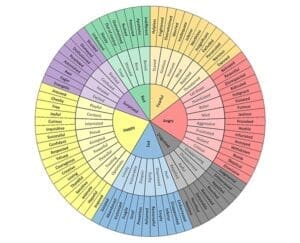In My Feelings: Experiencing & Understanding Emotions
Raise your hand if you have ever been in your feelings. Have you ever stopped and thought about what being “in my feelings” really means? Experiencing our emotions, and understanding what those feelings mean, is a critical aspect of any mental health journey. Read on for answers to the following questions:
- What are emotions?
- Where do emotions originate?
- Why is avoiding your emotions problematic?
- How do you explore and understand your own emotions?

The Ashwagandha plant (pictured here) is a shrub commonly used to relieve stress. However, there is little evidence for its use as an “adaptogen.”
What are emotions?
Did you know that your emotions are a bodily, physiological experience? For a long time, I thought of emotions as more abstract, something I could explore and control intellectually. That is how Western culture, and traditional Western psychotherapy models, tend to view emotions: seeing the mind as possessing and controlling the body and emotions. That is why many of us might be familiar with talking about our feelings – but we might not be as familiar with feeling our feelings.
Feeling your feelings, and sensing them as bodily experiences can be new, uncomfortable, and a bit scary for a lot of people – and yet it is a skill that can be learned and that can help us live with less distress and with greater authenticity. Feeling your feelings looks like asking the question, What tells you you’re feeling that way? How do you know that you are sad and not angry? What is your body signaling to you that you are experiencing joy or fear?

The 2015 Disney Pixar film, Inside Out, focused on a group of characters (pictured here) who represent individual emotions, such as Joy and Anger.
In your feelings: The emotions & where they originate
One of the psychotherapy models I pull from in my practice is Accelerated Experiential Dynamic Psychotherapy (AEDP), which believes an important step toward health is being able to feel our core emotions. Those core emotional categories are anger, sadness, joy, fear, disgust, excitement, and sexual excitement. Because these feelings can sometimes be overwhelming or because we want to get along with other people, we often try (consciously or unconsciously) to suppress or control these core emotions.
But here’s the thing: Emotions originate in a part of the brain that is deeper than the thinking structures of the brain, meaning that emotions are present and sending signals through our body before we are consciously aware of them. I like to think of emotions as indicator lights on a car dashboard. They are signals, alerting us to what is happening and what is needed. If we suppress or ignore those indicator lights, it is going to be hard to drive. Similarly, when we ignore or block our core emotions, it can be hard for us to know fully who we are and what we want. Attempts to block the experience of a core emotion can lead to feelings of anxiety, depression, guilt, or shame (what AEDP calls inhibitory emotions). Essentially, suppression of core emotions can cause distress. Experiencing them is where we can find growth and clarity.

Psychotherapists John Case Nemiah (pictured here) and Peter Sifneos introduced alexithymia, sometimes known as emotional blindness, in 1973.
No hard feelings: If you are avoiding your emotions, you are doing it wrong
Diana Fosha, who developed AEDP, describes feelings as “the experiential arc between the problem and the solution”, meaning that when we allow ourselves to feel an emotion and ride the wave of that emotion in our bodies, we gain clarity on what needs to happen next. For example, allowing ourselves to experience sadness could lead to acceptance. Experiencing anger might let us know that there is a boundary we need to set. Feeling excitement might tell us what is important for us to prioritize. Simply thinking about our sadness or anger or excitement will not always lead to that same sort of resolution or clarity. It is when we notice how emotion is moving through our body and when we stay with it that we are able to process emotion and find solutions.

The Feelings Chart (pictured here), or the Feelings Wheel, was developed by psychotherapist Dr. Gloria Willcox.
The era of good feelings: How to explore & understand your feelings & emotions
Here are some places to start if you would like to explore what it looks like to feel your feelings in addition to talking about them. (For those of you who have experienced trauma, tapping into the body can feel especially scary, so I would recommend having the support of a therapist as you begin exploring).
- Next time you notice an inhibitory emotion (anxiety, low mood, guilt/shame) coming up for you, try asking yourself the question: What is the core emotion I am feeling under the anxiety/shame, etc.? You can go through the list of core emotions, asking yourself “Am I sad? Am I angry? Am I excited?”
- Print or draw seven outlines of the human body (one for each core emotional category: Fear, anger, joy, sadness, disgust, excitement, sexual excitement). Draw where and how you feel each of the seven emotions in your body. You might want to experiment with different colors to indicate the temperature, energy, movement, and intensity of the emotions.
- Read It’s Not Always Depression by Hilary Jacobs Hendel or The Wisdom of Your Body by Hillary L. McBride.

Staff Therapist Amy Leonard (pictured here) joined CFR in the Spring of 2023.
About the Author
Amy Leonard, MSW, is a Philadelphia therapist accepting new online or in-person clients. Click here to book an appointment.
If you have questions about her practice or this article, you may reach Amy at aleonard@councilforrelationships.org or 215-770-2334 ext 7018.
See our Therapist & Psychologist Directory to find a different CFR therapist or psychiatrist near you.
